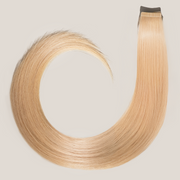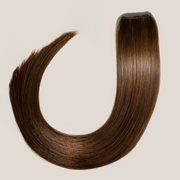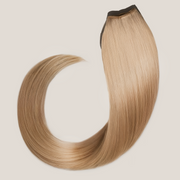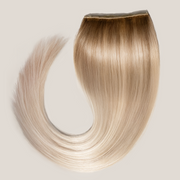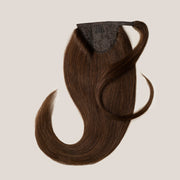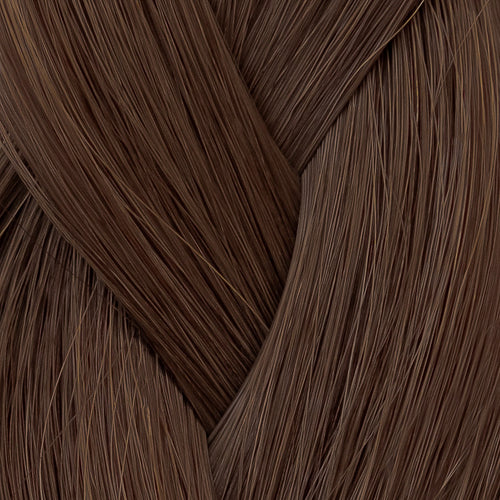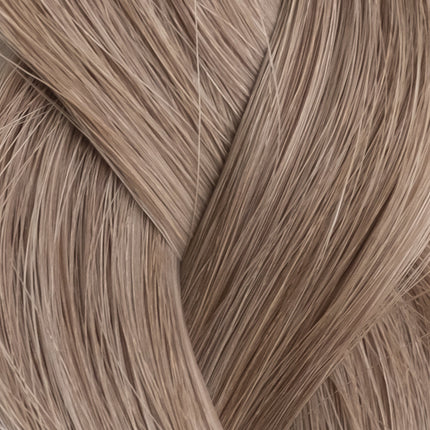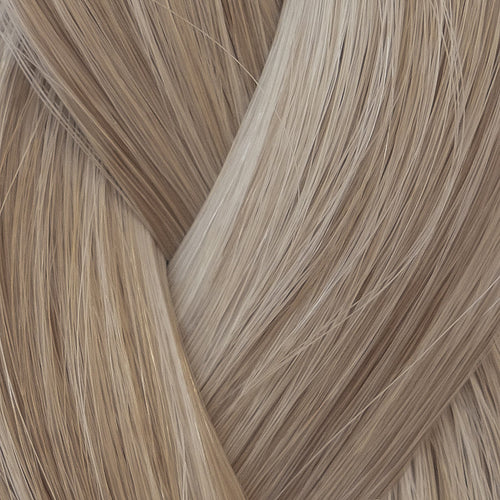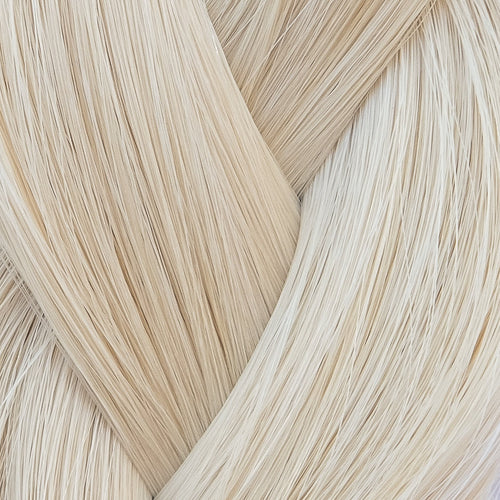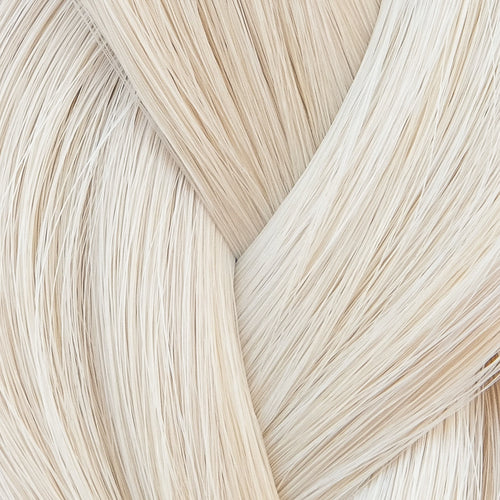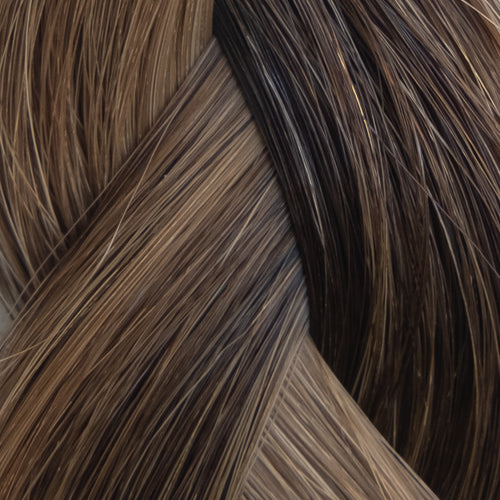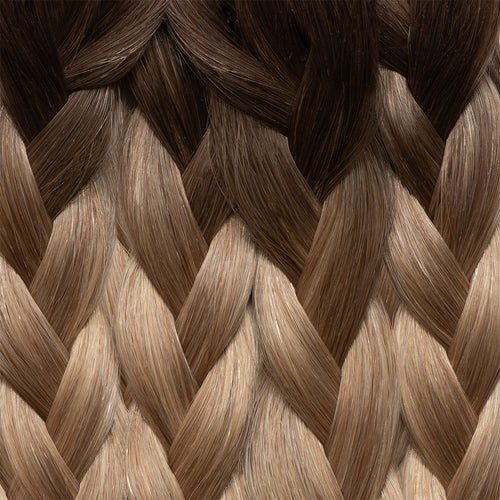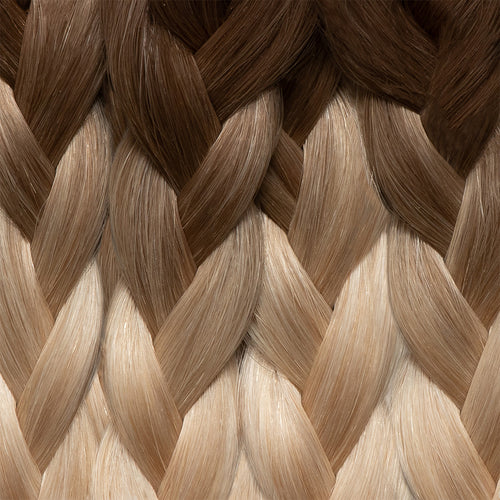The Complete Guide to Tape Hair Extensions in Australia: Expert Answers to Your Most Common Questions
Tape hair extensions have revolutionised the Australian hair industry, offering a semi-permanent solution for achieving longer, fuller hair with minimal damage. Whether you're considering your first set or looking to optimize your current extension care routine, this comprehensive, evidence-based guide answers the most frequently asked questions about tape-in extensions in Australia.
What Are Tape Hair Extensions and How Do They Work?
Tape hair extensions are thin, pre-taped wefts of hair—typically 4cm wide—that use medical-grade polyurethane adhesive to attach to your natural hair. The application involves a "sandwich" method where a thin section of your natural hair is positioned between two tape wefts, creating a secure, flat bond that sits close to the scalp.

Medical-Grade Adhesive Technology
The adhesive used in professional tape extensions is specifically formulated for hair applications, utilizing cyanoacrylate-based compounds similar to those approved by medical authorities for wound closure (US Patent 10196543B2). This medical-grade technology ensures strong, long-lasting bonds while remaining gentle on natural hair and scalp tissue (The Tape Lab).
Types of Tape Extensions Available in Australia
Classic tape extensions feature traditional 4cm wide adhesive strips with hair attached in a standard weft design. These extensions work excellently for most hair types and provide reliable, long-lasting results with proper application and maintenance

Invisible tape extensions represent the latest advancement in extension technology. Unlike traditional tapes where hair stops short of the tape edge, invisible tapes feature injection tape technology where hair extends completely to the edge, creating an ultra-thin, transparent seam that's virtually undetectable even upon close inspection. This makes them ideal for fine hair and high ponytails.

How Long Do Tape Hair Extensions Last in Australia?
Maintenance Schedule
Tape extensions require repositioning every 6-8 weeks as your natural hair grows. This maintenance window is crucial for preventing damage and maintaining a natural appearance. Leaving extensions in beyond 8 weeks can cause matting, tangling, and potential traction on your natural hair.
Overall Lifespan and Reusability
With proper care, premium Remy human hair tape extensions can be reused 2-6 times, providing a total lifespan of 6 months to 1+ year (Cliphair Lifespan Guide, Perfect Locks). AAA grade extensions typically allow 1-2 reapplications, while AAAAA grade Russian hair can often be reused 3-6 times with retaping (Cliphair Reuse Guide).
Factors affecting extension longevity:
- Hair quality (Remy vs. non-Remy, virgin vs. processed)
- Natural hair growth rate (faster growth requires more frequent maintenance)
- Washing frequency and technique
- Exposure to chlorine, saltwater, UV radiation
- Heat styling practices and temperature settings
- Use of oil-based or sulfate-containing products near bonds
- Sleeping habits and nighttime hair protection
Do Tape Extensions Damage Your Natural Hair? The Science Behind Safe Application
Professional Consensus on Tape Extension Safety
When professionally applied and properly maintained, tape extensions are among the least damaging hair extension methods available (Lullabellz Damage Study, HeadKandy Superior). Their lightweight design (approximately 2 grams per tape) and flat profile distribute weight evenly across the 4cm weft, minimizing stress on individual hair follicles (North Hair Comparison).
Understanding Traction Alopecia Risk
Traction alopecia is a form of hair loss caused by prolonged or repetitive tension on hair follicles (NIH StatPearls, Traction Alopecia Review). While this condition affects up to one-third of women of African descent who wear tight hairstyles, it can occur with any extension method when applied incorrectly (JAMA Dermatology 2023).
Research indicates that tape extensions, when properly applied, pose minimal traction alopecia risk compared to methods like tight braids, sew-ins, or improperly sized micro-rings (American Academy of Dermatology, Crown Clinic UK). The key is professional application with appropriate tension and placement (Dermatologist Perspective).
Damage Prevention Guidelines
To minimize any risk of damage from tape extensions:
- Professional application is essential – Certified extensionists understand proper placement, tension, and sectioning
- Wait 48-72 hours before first wash – Allows adhesive to fully bond (InStyle Aftercare)
- Use only extension-safe products – Sulfate-free, oil-free formulas near bonds
- Never leave extensions beyond 8 weeks – Prevents matting and excessive tension
- Professional removal only – Using proper removal solutions prevents breakage
How Much Do Tape Hair Extensions Cost in Australia? Complete Price Breakdown
Initial Investment
According to 2024-2025 Australian market data, tape extension costs vary significantly based on quality and location (Airtasker Australia):
Hair Extensions (Product Cost):
- Standard quality tape extensions: A$200-$600 per full head
- Premium Remy human hair: A$500-$1,200+ depending on length (20"-24")
Professional Installation Fees:
- Application service: A$100-$250 per session
- Experienced stylists in metropolitan areas: A$150-$300
- Total initial investment: A$600-$1,900
Ongoing Maintenance Costs
Retaping and Repositioning (every 6-8 weeks):
- Removal, cleaning, retaping, and reapplication: A$200-$365
- Replacement adhesive tabs: A$20-$50 per pack
Maintenance Products:
- Sulfate-free shampoo and conditioner: A$40-$70
- Professional removal solution: A$15-$30
- Heat protectant and styling products: A$20-$50
- Annual product maintenance cost: approximately A$150-$250
Cost-Effectiveness Analysis
When properly cared for, quality tape extensions like Jadore's premium range can be reused multiple times, making the cost-per-wear reasonable. For example, a $900 initial investment reused 3 times over 9 months equals approximately $33 per week for full, long hair—comparable to regular salon styling appointments.
How Many Tape Extensions Do I Need for a Full Head?
Standard Recommendations by Hair Type
The number of tape pieces required depends on your natural hair density, length, and desired result:
40 Pieces (20 Sandwiches) = 50-100 grams:
- Best for: Fine to normal hair density
- Purpose: Adding length to existing hair with subtle volume
- Result: Natural, undetectable appearance
60 Pieces (30 Sandwiches) = 150 grams:
- Best for: Medium to thick hair density
- Purpose: Full-head coverage with significant volume and length
- Result: Most popular choice for balanced transformation (Cliphair Gram Guide)
80+ Pieces (40 Sandwiches) = 200+ grams:
- Best for: Very thick hair or maximum volume needs
- Purpose: Complete transformation with dramatic fullness
- Result: Ultimate coverage and length
Special Considerations for Different Hair Types
Fine/Thin Hair: Use 30-40 tapes to avoid overwhelming natural hair. Consider invisible tape extensions for the most seamless, lightweight result (Beauty Club Fine Hair Tips, Kennaths Thin Hair Guide).
Medium Density: 40-60 tapes provide balanced volume (Big Kizzy Best Practices).
Thick/Dense Hair: 60-80 tapes ensure proper coverage and seamless blending.
Can You Swim with Tape Extensions? Pool and Beach Safety
Yes, you can swim with tape-in extensions, but protective measures are essential to maintain adhesive integrity and hair quality (Big Kizzy Swimming Guide, Cliphair Activity Guide).
Pre-Swimming Preparation
- Gently brush extensions to remove tangles
- Braid hair or secure in a tight bun to minimize movement
- Apply a protective silicone serum to create a barrier (Elite Hair Care Guide)
- Consider wearing a swim cap for extended swimming sessions or daily pool use
Water Type Considerations
Chlorinated Pools: Chlorine can weaken adhesive bonds and discolor lighter hair extensions, particularly blonde shades (SDX Hair). Limit exposure and rinse immediately after swimming.
Saltwater: Salt can be extremely drying to extensions (Hairlink Care). Pre-wet hair with fresh water to reduce salt absorption.
Post-Swimming Care Protocol
- Rinse immediately with fresh water
- Wash with sulfate-free, moisturizing shampoo
- Apply generous conditioner to mid-lengths and ends
- Use leave-in conditioner to restore moisture
- Gently squeeze excess water and air dry when possible
Frequency Guidelines: Occasional swimming (vacations, special occasions) is fine with proper care. Daily or frequent swimming significantly reduces extension lifespan and may require more frequent replacement.
How to Care for Tape Hair Extensions: Complete Maintenance Guide
Washing Frequency and Technique
Optimal Washing Schedule: Wash tape extensions 2-3 times per week maximum (Foxy Locks Washing Guide, Beauty Club Method, Sway Hair Frequency). Unlike natural hair, extensions don't receive oil from your scalp, so they don't require frequent washing and actually benefit from less exposure to water and cleansing agents.
Step-by-Step Washing Protocol
- Pre-wash detangling: Gently brush from ends to roots before wetting
- Wet hair thoroughly: Use lukewarm water (never hot) in an upright position
- Apply sulfate-free shampoo: Focus on scalp and roots, avoiding scrubbing tape bonds
- Rinse completely: Ensure all shampoo is removed from between tapes
- Condition mid-lengths to ends: Never apply conditioner to tape bonds or within 2-3cm of bonds (Lullabellz Complete Care)
- Rinse thoroughly: Use cool water for final rinse to seal cuticles
- Gentle drying: Squeeze excess water with microfiber towel, never rub
Best Products for Tape Extensions in Australia
Shampoo Requirements:
- Sulfate-free formula (sulfates break down adhesive) (Cliphair Product Guide)
- pH-balanced for optimal hair health
- Moisturizing ingredients like shea butter, aloe vera, or argan oil
- Color-safe formulas for dyed extensions

Products to Avoid:
- Sulfates (strip moisture and weaken adhesive)
- Heavy oils near bonds (coconut oil, castor oil cause slipping) (Lauren Ashtyn Collection)
- Alcohol-based products (dry out hair)
- Silicone-heavy conditioners (cause buildup)
Heat Styling Safety Guidelines
Tape extensions made from 100% Remy human hair can be heat styled, but precautions are essential (Athena Hair Styling):
- Temperature limit: Keep below 180°C (350°F) (Lemani Maintenance)
- Heat protectant mandatory: Apply before every heat styling session
- Avoid direct heat to bonds: Keep straighteners, curling irons away from tape area
- Minimize frequency: Limit heat styling to 2-3 times per week maximum
- Air dry when possible: Allow extensions to air dry to 80% before using blow dryer on low heat (Superior Hair Guide)
Nighttime Care Routine
Proper nighttime care is crucial for preventing tangling and matting.
Before Bed Checklist:
- Ensure hair is 100% dry (never sleep with wet extensions)
- Brush gently from ends to roots
- Create a loose braid or low bun (avoid tight pulling)
- Use silk or satin scrunchies (no elastic bands)
- Sleep on silk or satin pillowcase to reduce friction (Intact Hair Night Care)
Can Tape Extensions Be Reused? Retaping Process Explained
Yes, high-quality tape extensions can absolutely be reused multiple times when properly maintained (Cliphair Reuse Method, Instructables Guide).
Reusability by Hair Grade
- AAA Grade: 1-2 reuses (approximately 3-4 months total)
- AAAAA Grade: 3-6 reuses (6-12 months total) (Perfect Locks Reusability)
Professional Retaping Process
Step 1: Safe Removal
- Apply professional tape removal solution (alcohol-based or oil-based)
- Wait 2-5 minutes for solution to penetrate adhesive
- Gently separate bonds without pulling natural hair
Step 2: Thorough Cleaning
- Remove all old adhesive residue from wefts
- Wash extensions with clarifying shampoo
- Remove any removal solution completely
- Deep condition to restore moisture (SimplyHair Retaping)
Step 3: Complete Drying and Preparation
- Air dry or blow dry on low heat
- Straighten extensions completely
- Inspect for any damage or excessive shedding
Step 4: Apply New Adhesive Tabs
- Use high-quality medical-grade replacement tape (Medical Grade Tabs)
- Apply evenly to cleaned weft surface
- Ensure no air bubbles or wrinkles
Step 5: Professional Reapplication
- Have extensions reapplied following proper technique
- Wait 48 hours before washing
- Resume normal care routine
Are Tape Extensions Suitable for All Hair Types?
Ideal Candidates
Fine to Medium Hair: Tape extensions are considered the best choice for fine hair because they lay flat and distribute weight evenly
Straight to Wavy Hair (Type 1A-2C): These textures blend most easily with standard tape extensions (Viola Hair Types).
Normal to Slightly Oily Scalps: Appropriate oil production helps maintain healthy hair without compromising adhesive.
Special Considerations
Curly Hair (Type 3A-3C): Can work with tape extensions but requires:
- More frequent maintenance and styling to blend textures
- Professional color matching across curl pattern
- Possibly texturized or curly texture extensions (North Hair Curly Application)
- Extra care during detangling and washing
Very Oily Hair: Natural scalp oils can weaken tape adhesive, requiring more frequent maintenance appointments or alternative methods (Resident Hair Type Guide).
Very Coily Hair (Type 4A-4C): May be better suited to sew-in wefts or other methods that accommodate tighter curl patterns (Viola Texture Matching).
Severely Damaged or Chemically Over-Processed Hair: Consultation with a specialist is essential to determine if natural hair can safely support extensions.
Tape Extensions vs Other Methods: Comprehensive Comparison
Tape Extensions vs Clip-In Extensions
| Feature | Tape Extensions | Clip-In Extensions |
|---|---|---|
| Duration | Semi-permanent (6-8 weeks) | Temporary (daily application) |
| Application | Professional required | DIY at home |
| Appearance | Seamless, undetectable | Visible clips, less natural |
| Lifestyle | 24/7 wear, swimming, sleeping | Remove for sleep, exercise, swimming |
| Initial Cost | Higher ($500-$1,900) | Lower ($300-$600) |
| Long-term Value | Better (reusable, constant wear) | Good for occasional use |
Source: Sway Hair Comparison
Tape Extensions vs Micro-Ring/Nano Extensions
| Feature | Tape Extensions | Micro-Ring Extensions |
|---|---|---|
| Application Time | 1-2 hours | 2-4 hours |
| Profile | Flat, discreet | Small beads, slightly more visible |
| Maintenance Interval | 6-8 weeks | 8-12 weeks |
| Application Method | Adhesive tape | Metal/silicone rings (no glue or heat) |
| Best For | Fine to medium hair, quick results | Thicker hair, longer intervals |
Source: Hair Nova Comparison
Tape Extensions vs Fusion/Keratin Bond Extensions
| Feature | Tape Extensions | Fusion Extensions |
|---|---|---|
| Application Method | Cold adhesive (no heat) | Hot keratin fusion (heat required) |
| Damage Risk | Low (when professional) | Medium (heat application) |
| Longevity | 6-8 weeks | 3-4 months |
| Cost | $500-$1,900 | $1,000-$3,000+ |
| Removal | Quick with solution (30-60 min) | Longer process with acetone |
Source: Melissa Mae Guide, Hair Candy Comparison
Common Problems and Professional Solutions
Extensions Slipping or Falling Out
Causes:
- Oil-based products applied near bonds
- Washing within first 48 hours of application
- Conditioner or treatments applied to tape area
- Very oily scalp type
- Improper application technique or insufficient natural hair
Solutions:
- Use only sulfate-free, oil-free products near roots
- Keep conditioner 2-3cm away from tape bonds
- Clarify hair before application to remove buildup
- Have extensions applied by certified professional
- Consider more frequent maintenance if you have oily scalp
Tangling and Matting
Causes:
- Sleeping with wet hair
- Insufficient brushing (should brush 2-3x daily)
- Using wrong brush type (regular paddle brush)
- Lack of moisture and deep conditioning
- Not protecting hair while sleeping
Solutions:
- Always dry hair 100% before bed
- Brush with extension-safe brush (loop brush or wide-tooth comb)
- Deep condition weekly (avoiding bonds)
- Braid or loose bun for sleep with silk scrunchie
- Use silk/satin pillowcase
Visible or Bumpy Tape Bonds
Causes:
- Too much hair sandwiched in bond
- Improper sectioning or placement
- Bonds placed too close to scalp or part lines
- Using standard tapes on very fine hair
Solutions:
- Professional consultation for proper sectioning
- Consider switching to invisible tape extensions for finer integration
- Ensure bonds are placed away from natural parts and hairline
- Use single-sided tape application for very fine hair
The Importance of Professional Application
Why DIY Application Isn't Recommended
While some brands market tape extensions for at-home application, professional installation offers significant advantages that impact both appearance and hair health (Kiki Hair Expert Guide):
Benefits of Professional Application
- Proper hair assessment: Trained stylists evaluate hair type, density, condition, and scalp health to determine suitability
- Strategic placement: Correct positioning ensures comfort, natural movement, and prevents damage from tension
- Customized sectioning: Professional "brick-laying" pattern prevents gaps and visible lines
- Perfect color matching: Stylists can blend multiple shades for seamless color integration
- Appropriate tension: Too tight causes traction alopecia; too loose causes slipping. Professionals know the exact tension required
- Warranty protection: Many premium brands only honor warranties for professionally applied extensions
Certification and Training Standards
Look for stylists with:
- Certified extension training from recognized bodies
- Brand-specific certification (e.g, Jadore certified)
- Portfolio of previous work with similar hair types
- Understanding of hair health and traction alopecia prevention
Colour Matching for Perfect Integration
Professional Color Matching Techniques
Achieving seamless color integration requires more than matching a single shade.
1. Color Ring Assessment
- Professional color rings contain multiple shade samples
- Match against root color in natural lighting
- Consider undertones (warm, cool, neutral)
2. Multi-Shade Blending
- Most natural hair contains 2-3 different tones
- Blend multiple extension shades for dimensional color
- Mix colors using the "sandwich" method with different shades top and bottom (Custom Blending Technique)
3. Balayage and Highlight Integration
- Create natural-looking dimension using lighter tapes near face
- Gradually transition shades from root to ends
- Add lowlights for depth and realistic appearance
At-Home Color Matching Tips
If ordering extensions online:
- Order color swatches first (never rely on screen colors) (Wicked Roots Matching)
- Test swatches in natural daylight near a window
- Match to hair behind ear (most accurate natural color)
- Brush swatch with your hair to see color blend
- When in doubt, choose lighter shade (easier to darken than lighten)
Maximizing Your Extension Investment
Cost-Per-Wear Optimization Strategies
- Invest in Premium Quality: High-quality Remy hair lasts 3-6x longer than budget alternatives, making the higher initial cost worthwhile
- Follow Aftercare Religiously: Proper maintenance adds months to extension lifespan (Jadore Longevity Tips)
- Never Skip Maintenance: Regular 6-8 week appointments prevent damage that shortens lifespan
- Use Professional-Grade Products: Extension-safe products protect your investment
- Minimize Heat Styling: Air drying and heatless styles preserve hair quality
- Proper Storage Between Wears: For reusable extensions, store properly to maintain condition
- Consider Invisible Tapes for Fine Hair: While slightly more expensive, invisible tapes last longer on fine hair due to better integration and less stress
Choosing Quality Tape Extensions in Australia
Essential Quality Indicators
1. 100% Remy Human Hair
- Cuticles aligned in same direction (prevents tangling)
- Natural protein structure intact
- Can be heat styled, colored, and treated like natural hair
- Lasts significantly longer than non-Remy or synthetic alternatives
2. Double Drawn Quality
- Consistent thickness from root to tip (no tapering)
- Fuller, more luxurious appearance
- Better blending with natural hair
3. Ethical Sourcing
- Transparent supply chain
- Donor consent and fair compensation
- Quality control at every stage
- Reputable suppliers like Jadore Hair Supplies ensure ethical practices
4. Medical-Grade Adhesive
- Hypoallergenic formulation (Medical Grade Standards)
- Strong bond strength (6-8 weeks wear)
- Gentle removal without damage
- Skin-safe, non-irritating composition
5. Color Range and Consistency
- Wide shade selection for accurate matching
- Consistent color batch-to-batch
- Ability to order multiple tones for custom blending
Special Considerations for Australian Climate
Heat and Humidity Management
Australia's climate presents unique challenges for extension maintenance:
High Heat Regions (QLD, NT, WA):
- Increased sweating may require more frequent washing
- Use dry shampoo between washes to extend intervals
- UV protection sprays prevent sun damage and color fading
- Chlorine exposure more common—rinse immediately after pools
High Humidity Areas:
- Anti-frizz serums help maintain smooth appearance
- Silk pillowcases especially important to prevent moisture-related tangling
- More frequent brushing may be needed
Beach Lifestyle Considerations:
- Saltwater and sand require immediate rinsing
- Apply protective oil before beach activities
- Braid or bun hair to minimize exposure
- Deep conditioning treatments more frequently needed
Final Recommendations
Key Takeaways for Australian Clients
- Tape extensions last 6-8 weeks between maintenance with proper care
- They are among the least damaging extension methods when professionally applied
- Initial investment ranges A$500-$1,900 with ongoing maintenance A$200-$365 every 6-8 weeks
- Wash only 1-2 times weekly with sulfate-free products
- Quality extensions can be reused 2-6 times, maximizing investment
- Professional application is essential for safety and longevity
- Choose between classic tapes for reliable performance or invisible tapes for the most seamless, undetectable appearance
Making Your Decision
Tape hair extensions offer an excellent balance of performance, safety, and cost-effectiveness for Australian clients seeking longer, fuller hair. By:
- Choosing premium quality extensions from trusted suppliers like Jadore Hair Supplies
- Investing in professional application and maintenance
- Following evidence-based aftercare protocols
- Using only extension-safe products
- Attending regular maintenance appointments
You can achieve beautiful, natural-looking results that enhance your confidence and style while maintaining the health of your natural hair.
For more information about premium tape hair extensions, professional guidance, and Australia's most trusted source for 100% Remy human hair, visit Jadore Hair Supplies—your partner in hair transformation since 2010.
Medical Disclaimer: This article is for informational purposes only. Individuals with scalp conditions, hair loss disorders, or allergies should consult with a dermatologist or healthcare professional before getting hair extensions. Information about traction alopecia is based on peer-reviewed medical research but should not replace professional medical advice.
Sources: This comprehensive guide is based on research from peer-reviewed dermatological journals, professional extension training materials, Australian salon industry data, and expert guidelines from certified extensionists. All hyperlinked sources are cited throughout the article for verification and further reading.
